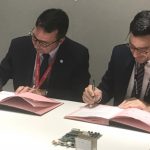As CEO Jean-Yves Courtois puts it, Orolia is focused on solving the hard problems. To do that, the France-based company, a global provider of resilient positioning, navigation and timing (RPNT) solutions, has become a technology integrator.
In recent years, Orolia has acquired and partnered with companies that offer complementary solutions to its positioning, GNSS simulations and emergency location technologies, with the goal of providing customers with the advanced solutions and support they need for critical aerospace, governmental and high integrity applications.
French defense contractor Safran, one of those partners, recently began the acquisition of Orolia from Eurazeo. The acquisition allows both companies to extend their RPNT solutions globally, with Safran now able to offer products and services in all aspects of PNT, inertial navigation, time and GNSS receivers and simulators. It also gives Safran more access to the U.S. market, where Orolia has a strong position, particularly with the U.S. government.
Safran will continue to develop Orolia, with Courtois leading the team. Orolia will be consolidated within Safran’s Equipment & Defense division upon closing, which should happen mid-year.
“There are plenty of cool things we can do by combining our timing technology and their sensor fusion and inertial technology. It’s really solidified the business case for them,” Courtois said. “With all the things we are bringing together, the critical mass, we are a very credible Resilient PNT leader.”
An emerging market
Courtois sees Resilient PNT as an emerging market that requires many different capabilities—which is why acquisitions like Spectratime, Spectracom, Talen-x and Skydel over recent years have been key to the company’s growth and success. Such acquisitions added time and frequency synchronization platforms, simulation equipment, Rubidium atomic clocks, and Interference, detection and mitigation (IDM) technologies to the company’s portfolio.
Focusing on offering a mix of capabilities is critical right now, Courtois said. Traditional technologies have their limitations in this world of new, more tangible threats. And it’s clear there’s no silver bullet to address these threats; many different technologies and capabilities, both traditional and new, must work together to outsmart them.
“About five, six years ago we saw this coming before people were even talking about Resilient PNT,” he said, “so we decided to focus on that and become a leader.”
Safran also has made its share of acquisitions, another benefit for Orolia, Courtois said. For example, Safran recently acquired Sensonor AS, adding the company’s MEMS inertial solutions to its portfolio.
A true integrator
Orolia is technology agnostic, Courtois said. Instead of trying to push one technology, the company serves as an integrator, providing customers with the greatest depth and breadth of upgradeable solutions possible.
“There’s a consensus that the future will be a combination of sensors and signals all over the place. It’s so complex that a customer with a problem to solve can’t really wrap his mind around it,” Courtois said. “We want to make things a little more clear so people can understand what they really have to solve, what they can expect from different solutions and what makes sense today.”
High expectations
Courtois sees great possibilities with this acquisition, and expects significant growth in the coming years. The goal is to move past the No. 1 and No. 2 companies in the market (Safran is now No. 3 in inertial), and that means being better technically, offering solutions with enhanced performance that open up new applications, and providing top-notch support to clients during critical operations.
“The only way to displace the giants is to just be better,” Courtois said. “And being better is primarily technology but it needs to go together with perfect customer support. That’s always been a key differentiator for Orolia.”






